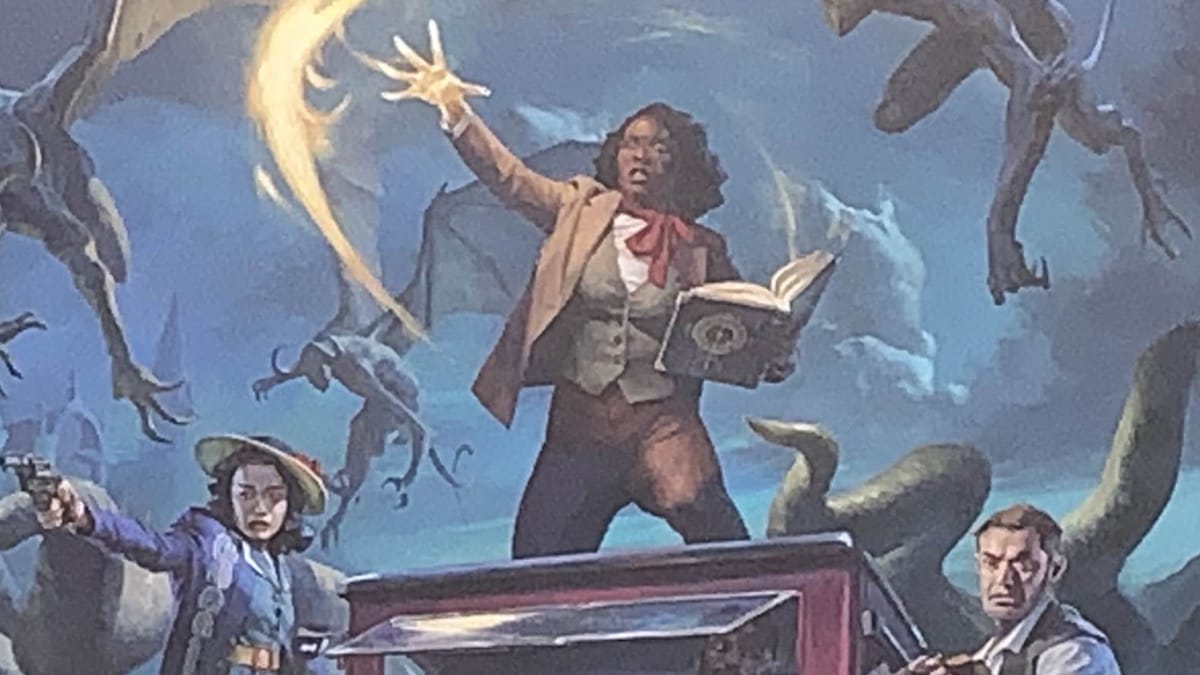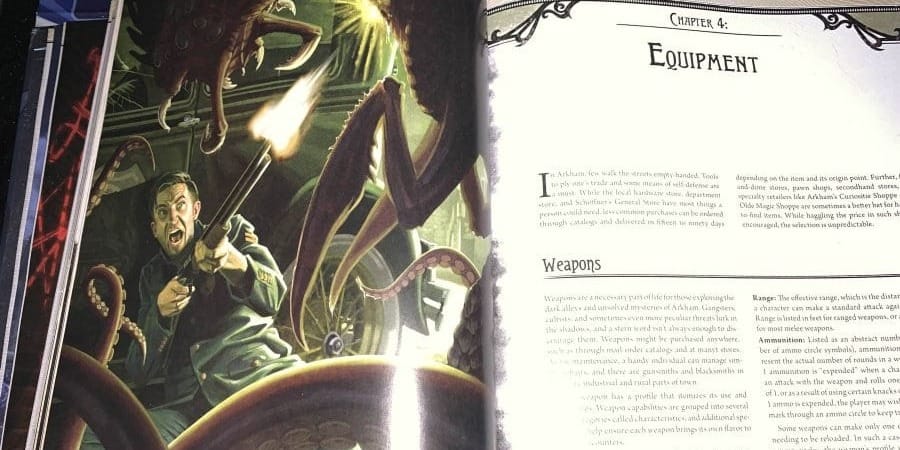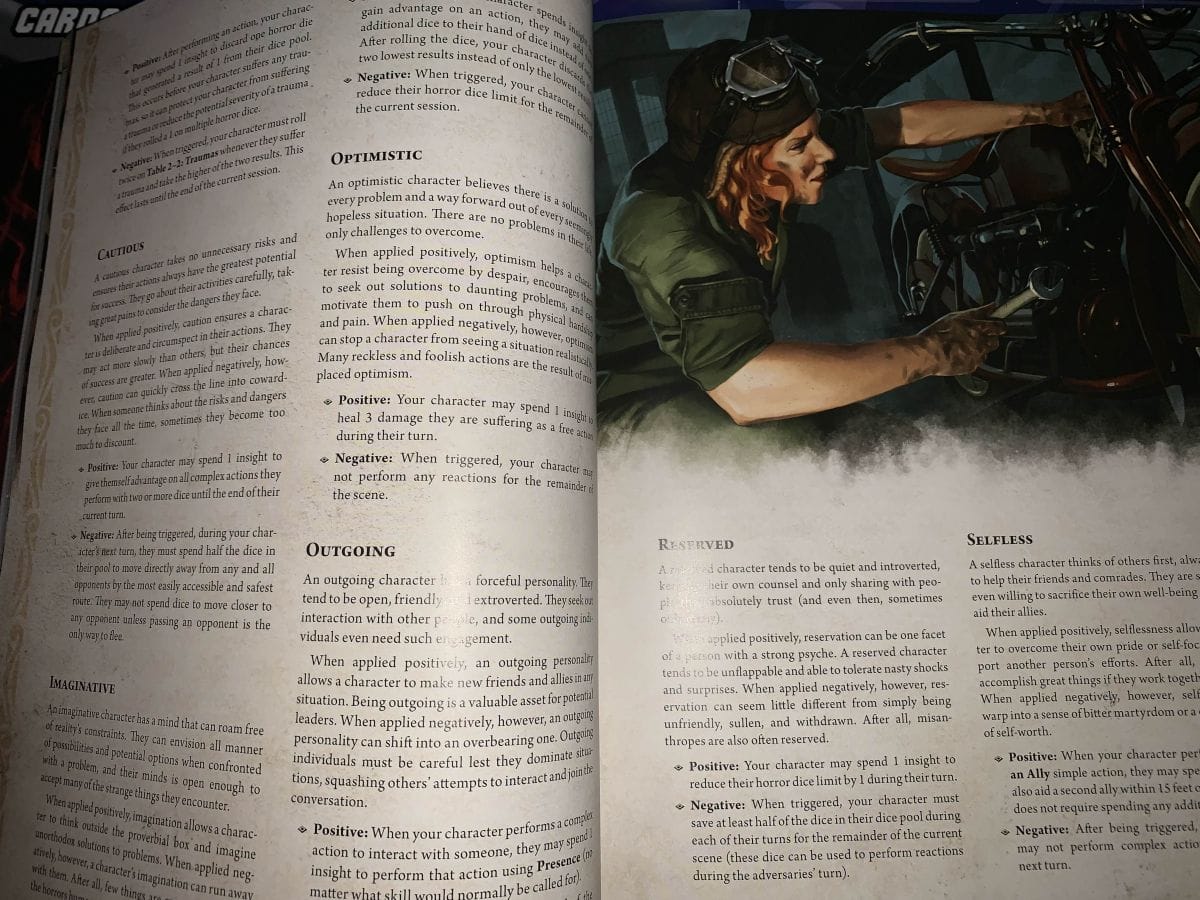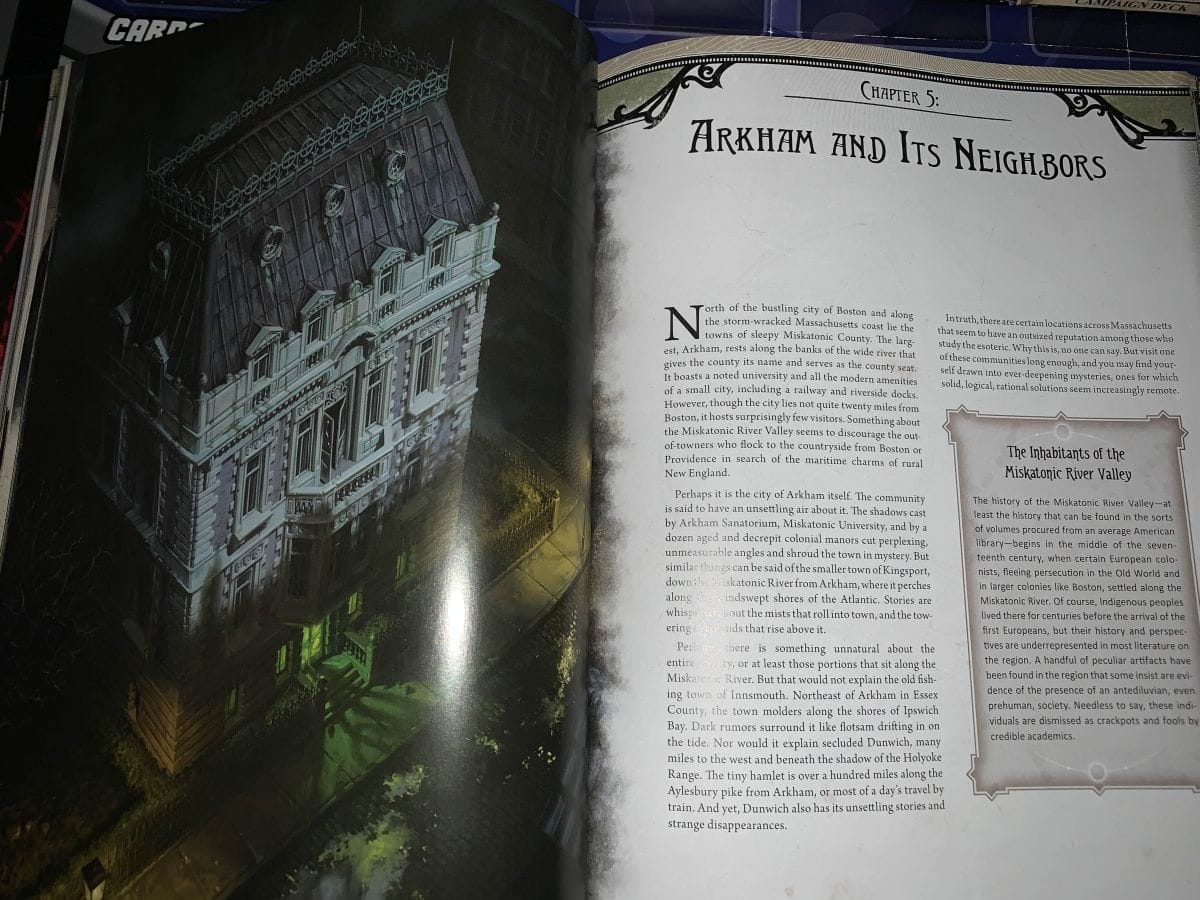
The Arkham Horror roleplaying game caught me by surprise. I am an avid player of Call of Cthulhu and the Arkham board games, and this was not a game I was expecting. I mean, who could it be for? Call of Cthulhu and Delta Green already have many people, including myself, covered. I must admit, I thought that there would be no room in the tabletop roleplaying game space. I will also admit that I was wrong. The Arkham Horror Roleplaying Game is a solid experience that can easily be twisted to fit different periods.
Cracking Open the Book
Arkham Horror: The Roleplaying Game is a 9-chapter, 248-page rulebook that contains just about everything you need to run the game. Chapter 1 covers the world of Arkham Horror extensively. Chapter 2 will take you through the rules, and that covers pages 15-38.
Chapter 3 covers the rules of character creation, and that will take you from pages 41-69. Chapter 4 covers the equipment, taking you from pages 81-101. Chapter 5 tells you all about Arkham, Dunwich, Innsmouth, Kingsport, and Providence. Chapter 6 is for the game master and will take you from pages 137-152.
Chapter 7 covers the Ancient Ones, taking you from pages 155-184. Chapter 8 covers the Allies and Enemies and contains NPCs and monsters. Chapter 9 is the adventure called Terror At The Tick-Tock Club. I really like the Allies and Enemies section because it provides a good, usable foundation for people and creatures that you can insert into your game.

The artwork in this game makes me so damn happy it’s not even funny. Every single piece of artwork in this game is thoughtful, evocative, and packed with character and flavor. The full-page artwork pushes the boundaries of what I thought Arkham artwork could look like. This is one of my favorite artworks in any Cthulhu-themed media.
As for the layout of this book, it's nothing short of stellar. You won’t find that the rules are cut off by lore or weird spacing. Everything is detailed enough to get going and for the most part, the book contains everything you'll need to play. I do wish the game master section was more extensive, and the campaign could’ve been named better.
The Rules
The Arkham Horror roleplaying game uses a dynamic dice pool. What that means is that each character has their own dice pool, and they spend dice from their pool when they perform a task. My test group and I are obsessed with this system because it makes the game feel reactive. Your dice pool shrinks when your character gets hurt and will refill at specific times.
The Dice Pool has rolls for refilling: this typically happens during a narrative scene during the beginning of their turn. The Dice Pool limits can increase and decrease during the game. I find that this works extremely well and is very fluid once the players get the hang of the mechanic.
Now, there are many skills: The way that the skills are measured is Bad (+6), Normal (+5), Good (+4), Amazing (+3), Phenomenal (2+.) Aside from that, you have your normal attributes; Agility, Wits, Presence, Intuition, Knowledge, Resolve, Melee Combat, Ranged Combat, and Lore.

Presence and Lore have been among my favorite attributes to see in the game, but during the test game, my players were making full use of everything. There is a section here (page 18) that details what each Skill can be used for: this is extremely clear and very useful, especially for on-the-fly choices.
As for an overall look at the system, I really like the Dynamic Pool System, otherwise known as the DPS. Using a D6 is a nice break from the D100 and the D20 that I’m used to. It makes performing checks extremely easy; all you have to do is roll one of your dice from your pool vs. one of your stat numbers. You can meet or beat the number to succeed in the check.
Scenes and Actions make up the meatt and potatoes of the system. Scenes are either narrative or structured, narrative being my players' favorite part of the system. Narratives are free-flowing, so this is where a lot of the roleplaying comes in, as well as the exploration. Structured scenes are where the more gritty bits of gameplay, such as combat, come into play.
Now, let’s side-step and talk about damage. Damage (with a capital D because there are multiple kinds) is a representation of physical injury, while Horror is a representation of your mental injuries. Horror adds Horror Dice to your character.
Character Creation is a Blast!
Character creation is broken down into the following steps.
- Determine your background: You’re choosing where your character came from and what they did before they became investigators.
- Choose a personality trait: You select one trait for your character that provides a unique advantage or disadvantage.
- Choose an archetype: Now, you have to choose an archetype. To put it simply, this decides what your character can be particularly good at and provides a list of special abilities called Knacks.
- Determine starting skill level: Most of your skills start at 6, and yes, that is the worst skill level. You can improve some of your character’s skills during this step.
- Choosing to start equipment and character advancements: Your character now gets some customization options and more advancement.
The reason we had so much fun with this is because of how different it felt from Call of Cthulhu. Arkham Horror is much more action-packed, and the character creation reflects that nicely. The skills are felt throughout the game, both using the dice as well as the game master, making sure that each skill pops up often enough for the players to get some use out of them.

Backgrounds and Personality traits are a nice touch and ones that my players spent at least 45 minutes debating over. As the game master, I enjoy these because it gives me something extra to work with for my players.
Combat and the Game Master Section
Combat flows nicely and never feels like it takes too long. I like how there never feels like there’s a dull moment within the combat portions. The gunplay is quick, and because I have plenty of experience running gunplay, I was able to make it even more cinematic without any tweaking. A large part of this is because of how well the book is laid out and how clear the rules are.
One issue I have with this book, though, is the small game master's section. I understand that they wanted to keep the handbook on the smaller end, but if you’re new to tabletop roleplaying games, the game masters section doesn’t provide much in the way of great advice. However, the campaign at the end of the book is extremely fun. I won’t spoil anything, but the adventure is extremely well-written and easy to follow. I ran it once as it was written and again to insert it into my custom setting. The adventure does not need any tweaking to run.
Final Thoughts
Arkham Horror is well with the time, especially for fans of the board games. If you’re expecting a replacement for Call of Cthulhu, this might not be the game for you because it leans in a different direction completely.
The mechanics are fun and well written, and the book layout is script. Flipping back and forth never felt like a hassle, and we especially appreciated the flow of the rules. As for combat, it is the easiest of any of these Cthulhu games that I have gotten to run thus far.
Arkham Horror The Roleplaying Game
Excellent
Arkham Horror is action-packed and lightweight. You won’t be spending days reading this handbook, instead, you’ll be tossed right into the action. The character creation is smooth, and the book is written extremely well.
Pros
- Fantastic artwork.
- The book's layout flows nicely and makes it easy to read.
- The adventure at the end of the book is easy to run and or insert into your own setting.
Cons
- The game masters section could’ve been longer and provided more tips and advice for running Arkham Horror.
This review is based on a retail copy provided by the publisher.
